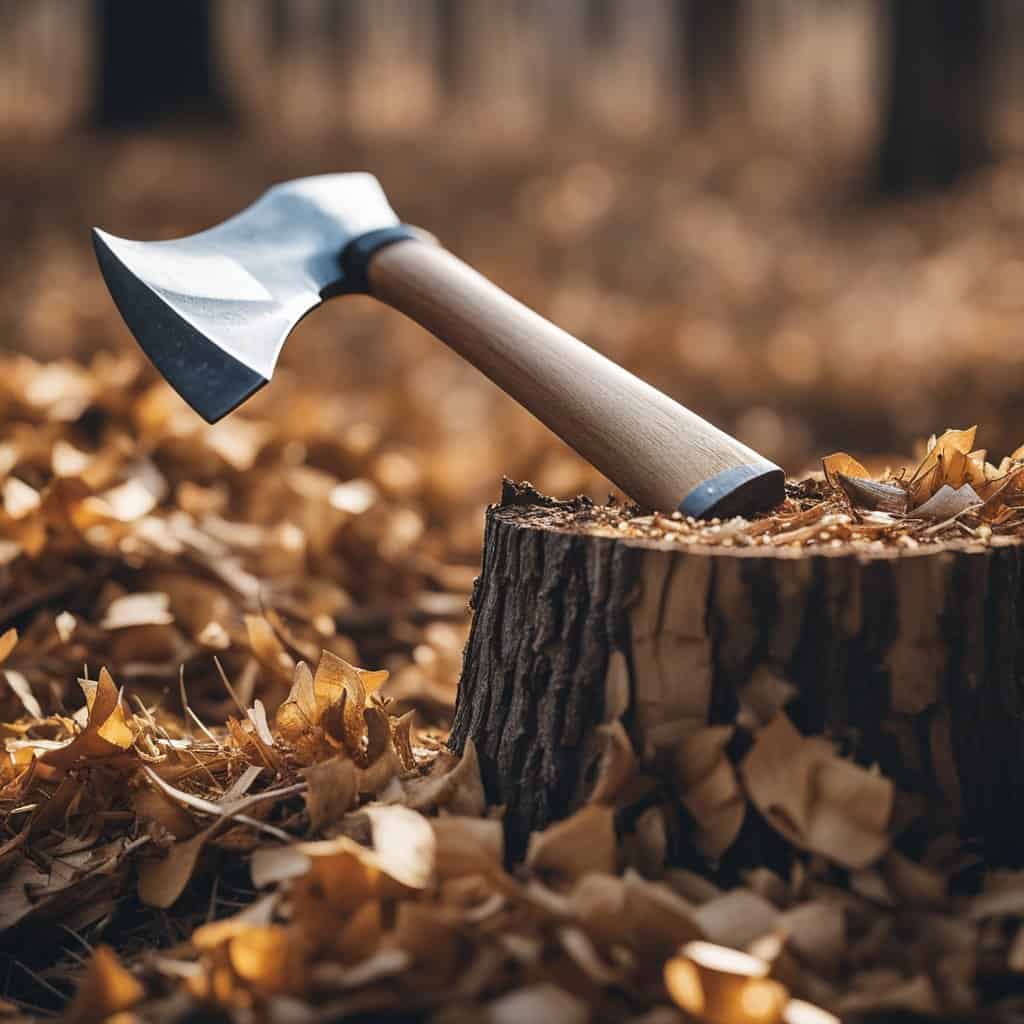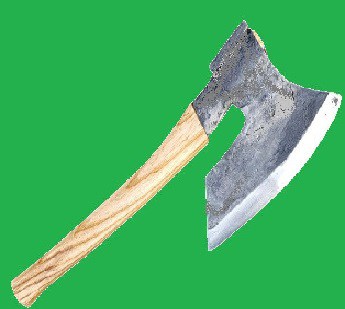Axes and hatchets are standard tools in a variety of trades that are described as heavy-bladed tools, with the blade set at a right angle to the handle. Both are for chopping and are most often used for cutting wood.
Table of Contents
What Are the Differences?
Hatchets are much smaller than axes, whereas axes are much larger and heavier tools. Due to an axe’s large size and weight, two hands are required to utilize it safely compared to the hatchet’s size and weight, which you can safely use with one hand. Axe heads have a flat back, except those axes intended for particular uses, like a fire axe. In addition, axes often have a much longer handle and a heavier head for more impact and power.
Hatchets are often designed with hammerheads or small pry blades on the back of the head to add versatility to their usage.
| HATCHET | AXE | |
| SIZE: | SMALL | LARGE |
| WEIGHT: | LIGHT | HEAVY |
| EASE OF USE: | ONE HAND | TWO HANDS |
| TASKS: | CHOPPING BRANCHES | CHOPPING TREE |
| SHARPENING STICKS | CHOPPING FIREWOOD | |
| BREAKING ICE | BREAKING LARGE OBSTACLES | |
| WEAPON | WEAPON | |
| MULTITOOL | ||
| BEST TO HAVE: | BACKPACKING | HOME |
| HUNTING | SUMMER PROPERTY IN WOODS | |
| CAMPING | CAMPING | |
| SNOW MOBILING | FARMING | |
| HIKING | ||
| EMERGENCY KIT |
Uses for an Axe and Hatchet
1. Chopping Wood
The most common use for both tools is chopping wood, and you can strike and split logs with either blade.
The axe is ideal for cutting through large logs or trees. Once the tree is down, you can further chop the large cords/wood piles into smaller sizes. Again, the weight helps deliver decisive blows to make felling thick wood easier.
Hatchets are for tasks that take chopping but need a lighter touch and more control. For example, splitting small branches, breaking small branches for tinder or firestarters is more a task for the hatchet than the axe.
2. Breaking Large Obstacles
The weight of an axe provides a lot of impacts to break through obstacles. For this reason, the axe is used in emergencies. You can break out of or into a structure. For example, cutting out the back of a tent as a bear is coming in the front door.
Hatchets and axes are commonly a part of survival gear or outdoor gear.
While it might not work as well as a shovel, you can use an axe or hatchet to break ground in a pinch.
3. Large Animal Butchering
An axe will work in situations that involve cutting through heavy limbs, hide, and muscle; though it isn’t necessarily ideal, it will work.
For skinning or cutting through joints of small animals, a hatchet will work due to its lighter weight and your ability to control the hatchet.
4. Weapon
An axe or hatchet can be utilized as a weapon. An axe makes a heavy, sharp weapon, and the hatchet a small, more precise blade and can be highly versatile to protect you from animals. Be careful as a hatchet can be a close-quarters weapon that does a lot of damage in a small space. Finally, as an added note or unique twist, axes have symbolized heraldry or coats of arms throughout history.
5. Sharpening Sticks
Often stick ends are sharpened to cook food or are hammered into the ground to hold a rope. A hatched can help you produce a lot of sharpened sticks in a short amount of time. An axe, on the other hand, due to its long handle, weight, and head size, is not the best choice for this fine work.
6. Ice Breaking
You know how hard it is to break through the ice if you like ice fishing. Hatchets work better for breaking the ice, with less force to risk extreme fractures. Utilizing the strength and weight of an axe leaves you vulnerable to the ice cracking around you, which is unsafe and may leave you in a predicament.
7. Multi-Tool
Hatchets often have different shapes added to the back of the head to make them more versatile. The most common addition is a hammerhead. Other additions include a prying implement or an icepick style implement which you would not find on an axe.
Which is Better – Axe or a Hatchet?
Different applications need different tools. So, for tasks or situations that require more power and weight, an axe, for jobs that require more control, a hatchet.
When Would I Want An Axe?
The axe is the master tool for breaking through heavy or sturdy obstacles. If you’re anticipating needing a lot of striking power with an edge, the axe is the best choice. Axes are most commonly used as emergency tools because they can get the job done quickly. However, they’re also helpful for farmers and woodsmen when working on various tasks.
What About a Hand Axe?
The hand axe is an excellent compromise between regular and hatchet. A hand axe is a minature axe. Some confuse a hand axe with a hatchet but the two are not the same.
It has the smaller, one-handed design of the hatchet but has some of the weight and power of an axe. So if you aren’t sure whether you’ll want a hatchet or an axe, consider the hand axe as this a potentially best of both worlds.
When Would I Want A Hatchet?
Hatchets are a highly recommended survival tool. They’re lighter weight than axes and often far more versatile in the number of tasks they can do.
The hatchet is a crucial lightweight piece of equipment for backpackers, hunters, or campers. In a pinch, you can use a hatchet in many of the tasks where you would use a regular axe, but the task will take much longer. However, when you’re working in a situation where space is limited or control is needed, the hatchet is a solid chopping tool.
Which Would I Use for Specialized Tasks?
Axes are often modified to unique shapes for specialized tasks, whereas hatchets are less likely to be specialized, though many manufacturers offer options for additions. So, if looking for a modified axe, you will need to do some more research with the industry before deciding.
For Cost Effectiveness:
Hatchets are often cheaper than axes due to the smaller amounts of material used in constructing the tool. Therefore, a hatchet is generally a better choice if your budget is limited.







